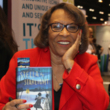The Mighty Miss Malone
(Libby/OverDrive eBook, Kindle)
Available Platforms
Description
In the Newbery Medal and Coretta Scott King Award–winning Bud, Not Buddy, Bud met a girl named Deza Malone in a Hooverville. This is her story. “We are a family on a journey to a place called wonderful" is the motto of Deza Malone's family. Deza is the smartest girl in her class in Gary, Indiana, singled out by teachers for a special path in life. But the Great Depression has hit Gary hard, and there are no jobs for black men. When her beloved father leaves to find work, Deza, Mother, and her older brother Jimmie go in search of him, and end up in a Hooverville outside Flint, Michigan. Jimmie's beautiful voice inspires him to leave the camp to be a performer, while Deza and Mother find a new home, and cling to the hope that they will find Father. The twists and turns of their story reveal the devastation of the Depression and prove that Deza truly is the Mighty Miss Malone. “Witty and moving.” —The Wall Street Journal “The fluidity of the writing, the strong sense of place and time combined with well-drawn characters will captivate and delight. . . . a fitting literary companion to Bud Caldwell.” —Kirkus Reviews, Starred “Curtis threads important bits of African-American history throughout the narrative. . . . Some readers will feel they are due a bit of happiness; others will be struck by how little has changed in 75 years for the nation’s have-nots.” —Publishers Weekly, Starred
More Details
Excerpt
Similar Titles From NoveList
Similar Authors From NoveList
Published Reviews
Booklist Review
Deza Malone, 12, has a couple of big things going for her. She comes from a strong family, and she is smart as a whip. But there is plenty of bad to go along with the good. It's 1936 and her dad can't find work; her brother, Jimmie, he of the beautiful singing voice, isn't growing; and her teeth, full of cavities, require treatment of cotton soaked with camphor. Can things get worse? Certainly. Her father disappears and her mother moves the family from Gary to Flint, which lands the trio in a Hooverville shack. Then Jimmie takes off to sing. Curtis tries to do too much here. Consequently, just when readers are getting invested, the story changes course or important plot points are dropped. Deza is devastated when she overhears her father say her rotting teeth make him avert his head, but her suffering is forgotten until, at the conclusion, she goes to a dentist. On the plus side, Deza is a snappy character that will grab readers, and Curtis' portrayal of a family's love for each other feels real and true. HIGH-DEMAND BACKSTORY: Newbery-winner Curtis has a huge following. Readers will be enticed by his return to the Depression-era setting of Bud, Not Buddy (1999) and his reintroduction of Deza, one of the characters from that book.--Cooper, Ilene Copyright 2010 Booklist
Publisher's Weekly Review
In Depression-era Indiana, Deza Malone's opportunities are slim despite her potential. She's got the smarts, the determination, and the attitude, but her family lacks the resources to help her grow to her full potential-and things only become worse when her father needs to leave for Michigan to find work. Narrator Bahni Turpin's exuberant performance and raspy voice make this an enjoyable and lively audio edition. Deftly rendering Deza, Turpin produces an impressive range of emotions for the young protagonist as she confronts challenges. For male characters, the narrator lowers her voice a few octaves, creating spot-on voices and an audiobook guaranteed to appeal to young listeners. Ages 10-14. A Wendy Lamb hardcover. (Jan.) (c) Copyright PWxyz, LLC. All rights reserved.
School Library Journal Review
Twelve-year-old Deza Malone's family is struggling with Depression-era life in Gary, Indiana, but their strength to persevere is a testament to resilience, good humor, high hopes, and courage. As her father searches for work far away from home, Deza, her mother, and her brother are determined to follow him. When they do, the trials of racism, hunger, and homelessness are palpable. Turpin's talent embodies the voice of Deza as she journeys to find not only herself but also her most important family values. Common Core Standard: RL.7.9. Compare and contrast a fictional portrayal of a time, place, or character and an historical account of the same period as a means of understanding how authors of fiction use or alter history. Content Standard: Georgia Department of Education (English Language Arts, Grade 7: ELA7R1) c. Relate a literary work to information about its setting or historical moment. (c) Copyright 2012. Library Journals LLC, a wholly owned subsidiary of Media Source, Inc. No redistribution permitted.
Horn Book Review
To her father, twelve-year-old Deza Malone is "my Darling Daughter Deza," "that sassy, smart, beautiful, charming little girlmy Mighty Miss Malone." But it's 1936, and the Depression has hit Gary, Indiana, hard. The loving Malone family is desperately poor and withering away. Older brother Jimmie hasn't grown in three years, Mrs. Malone's clothes hang on her, and Deza's teeth are so bad it's as if she's rotting from the inside. In one poignant scene, Deza overhears her beloved father say to her mother, "I can't breathe out of my nose when I'm near Deza because of the smell of her teeth. How sick is that?" Mr. Malone lights out for Flint, Michigan, in search of work, planning to write when his family can join him. But when they don't hear, they journey to Flint in search of him. As incandescent and full of good cheer as Deza is (and as she was when introduced in Bud, Not Buddy, rev. 11/99, as the little girl who kissed Bud in a Hooverville camp), and as funny as the book's early scenes are, this is an angry novel, unflinching in its portrayal of poverty, with plenty of resonance with the fifteen million poor children in the United States today. There's certainly a measure of hope, hard won, by the end of the novel, but this is a depiction of a family and a nation that embody poet Robert Burns's lines, much repeated here: "the best-laid schemes of mice and men gang aft a-gley." dean schneider (c) Copyright 2012. The Horn Book, Inc., a wholly owned subsidiary of Media Source, Inc. No redistribution permitted.
Kirkus Book Review
Bud, Not Buddy (Newbery Medal and Coretta Scott King Author Award, 2000). Now, she is the dynamic and engaging heroine of her own story. Deza takes great pride in being the best student in school and the champion of her musically gifted but challenged older brother. Although the Malones are barely surviving the Depression in Gary, Ind., Deza has a strong sense of self and hope for a better life. As she writes in her school essay, "We are the only family in the world, in my ken, that has a motto of our own! That motto is We are a family on a journey to a place called Wonderful.' I can't wait until we get there!" Despite severe economic and racial restrictions, the strength of their familial bond remains strong, but even that connection is sorely tested when Mr. Malone returns to his hometown of Flint, Mich., seeking work. Deza, her brother Jimmie and their mother set out to find him as their situation becomes dire. With his distinctive style of storytelling that seamlessly presents the hardships and finds the humor in tough circumstances, Curtis forges the link between characters and readers. The fluidity of the writing, the strong sense of place and time combined with well-drawn characters will captivate and delight. Deza is one great heroine in her own right, a fitting literary companion to Bud Caldwell. (Historical fiction. 9-12)]] Copyright Kirkus Reviews, used with permission.
Booklist Reviews
Deza Malone, 12, has a couple of big things going for her. She comes from a strong family, and she is smart as a whip. But there is plenty of bad to go along with the good. It's 1936 and her dad can't find work; her brother, Jimmie, he of the beautiful singing voice, isn't growing; and her teeth, full of cavities, require treatment of cotton soaked with camphor. Can things get worse? Certainly. Her father disappears and her mother moves the family from Gary to Flint, which lands the trio in a Hooverville shack. Then Jimmie takes off to sing. Curtis tries to do too much here. Consequently, just when readers are getting invested, the story changes course or important plot points are dropped. Deza is devastated when she overhears her father say her rotting teeth make him avert his head, but her suffering is forgotten until, at the conclusion, she goes to a dentist. On the plus side, Deza is a snappy character that will grab readers, and Curtis' portrayal of a family's love for each other feels real and true. HIGH-DEMAND BACKSTORY: Newbery-winner Curtis has a huge following. Readers will be enticed by his return to the Depression-era setting of Bud, Not Buddy (1999) and his reintroduction of Deza, one of the characters from that book. Copyright 2012 Booklist Reviews.
Publishers Weekly Reviews
Even ardent fans of Curtis's Newbery winner, Bud, Not Buddy, may not remember Deza Malone, who shares dishwashing duties with Bud Caldwell during his brief stay at a Hooverville in Flint, Mich. Responding to readers' pleas that he write a book with a female main character, Curtis traces the path that led Deza's family to homelessness. It's 1936 in Gary, Ind., and the Great Depression has put 12-year-old Deza's father out of work. After a near-death experience trying to catch fish for dinner, Roscoe Malone leaves for Flint, hoping he'll find work. But Deza's mother loses her job shortly after, putting all the Malones out on the street. As in his previous books, Curtis threads important bits of African-American history throughout the narrative, using the Joe Louis–Max Schmeling fight to expose the racism prevalent even among people like the librarian who tells Deza that Louis is "such a credit to your race." Though the resolution of the family's crisis is perhaps far-fetched, some readers will feel they are due a bit of happiness; others will be struck by how little has changed in 75 years for the nation's have-nots. Ages 10–14. (Jan.)
[Page ]. Copyright 2011 PWxyz LLCSchool Library Journal Reviews
Gr 4–7—In 1936 Gary, IN, 12-year-old Deza Malone is an outstanding student and beloved daughter in an African American family challenged by economic hardship. Her mother's job as a domestic allows them to just get by, but leaves them unable to address Deza's rotting teeth and older brother Jimmie's stunted growth. When her father seeks work in Michigan and fails to keep in touch with them, Mother packs them up to go and find him. Their journey takes them to a Hooverville camp where Jimmie's beautiful singing voice is discovered by an itinerant musician who convinces him to strike out on his own. Mother and Deza try to make a life for themselves in Flint but are discouraged by poverty and discrimination and their inability to find Father. When Deza hears that Jimmie is making it big in Detroit, she sets out to find him, starting a chain of events that lead to a hopeful yet heartbreaking conclusion. The strength of this companion to Bud, Not Buddy (Delacorte, 1999) is its vivid characterization and clear sense of place and time. Deza is an appealing, indomitable heroine whose narrative voice reflects both wit and pathos. Period details are skillfully woven into the story with the Joe Louis vs. Max Schmeling fight playing an important role in underscoring the sense of defeat for African Americans as they struggle with the Depression. Careful readers may be mystified by the discrepancies between Buddy's account of meeting Deza and Deza's, and they might wish for a more comforting resolution, but Curtis does not sugarcoat reality and focuses instead on the resilience of a memorable character. An absorbing read.—Marie Orlando, formerly at Suffolk Cooperative Library System, Bellport, NY
[Page 114]. (c) Copyright 2012. Library Journals LLC, a wholly owned subsidiary of Media Source, Inc. No redistribution permitted.Reviews from GoodReads
Citations
Curtis, C. P. (2012). The Mighty Miss Malone . Random House Children's Books.
Chicago / Turabian - Author Date Citation, 17th Edition (style guide)Curtis, Christopher Paul. 2012. The Mighty Miss Malone. Random House Children's Books.
Chicago / Turabian - Humanities (Notes and Bibliography) Citation, 17th Edition (style guide)Curtis, Christopher Paul. The Mighty Miss Malone Random House Children's Books, 2012.
Harvard Citation (style guide)Curtis, C. P. (2012). The mighty miss malone. Random House Children's Books.
MLA Citation, 9th Edition (style guide)Curtis, Christopher Paul. The Mighty Miss Malone Random House Children's Books, 2012.
Copy Details
| Collection | Owned | Available | Number of Holds |
|---|---|---|---|
| Libby | 1 | 0 | 0 |


































